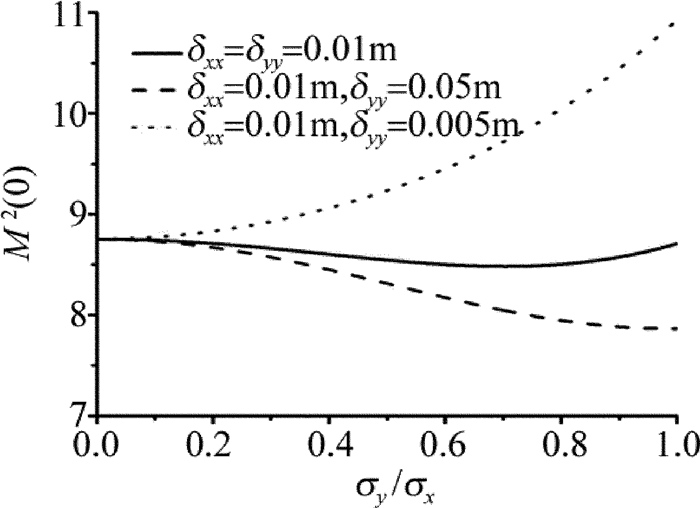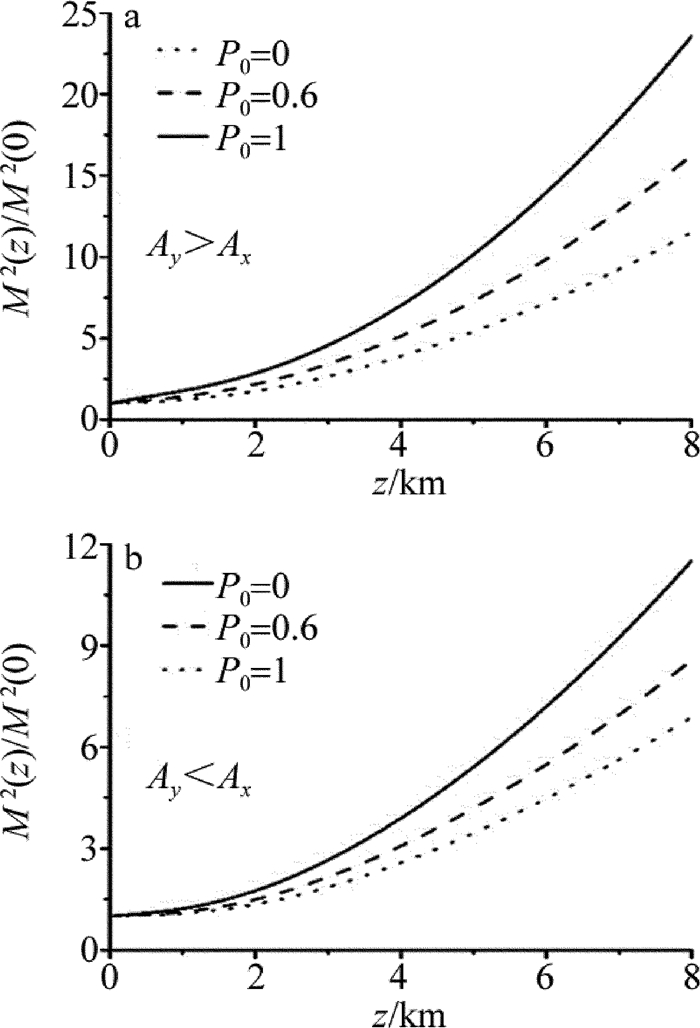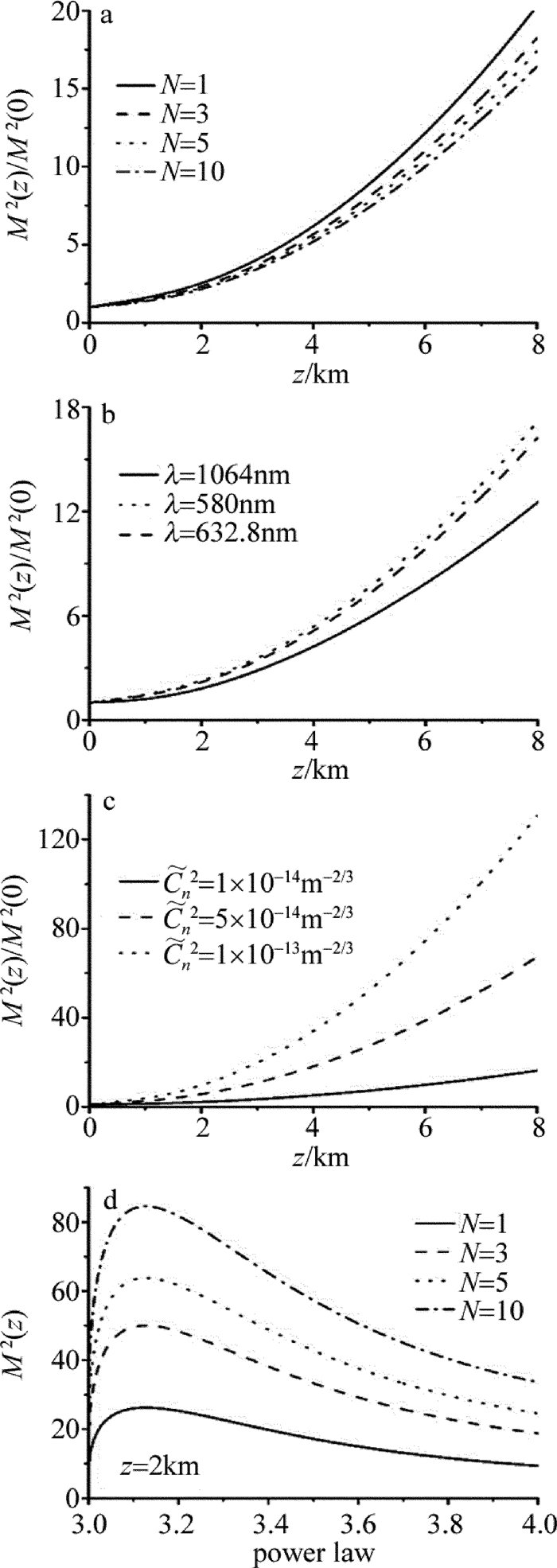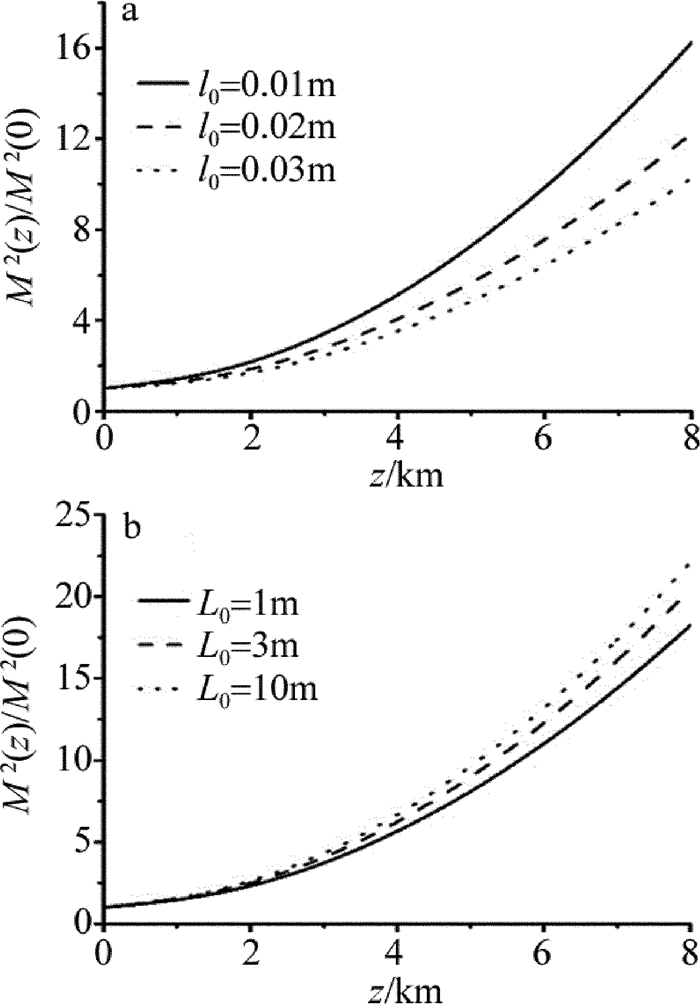HTML
-
近年来,激光在大气湍流中的传输特性得到广泛研究[1-8]。实验表明,部分相干光在大气传输中的表现优于完全相干光,很多学者对部分相干光束在自由空间和各向同性介质中传输进行了深入研究[1-2]。自从GORI等人[3]提出了构建具有特殊关联空间结构的部分相干光束的充分条件以来, 一系列具有特殊关联空间结构的部分相干光束的理论模型相继被提出, 并且在实验上产生,如多高斯-谢尔模型(multi-Gaussian-Schell model, MGSM)光束[4]、拉盖尔-高斯-谢尔模型(Laguerre-Gaussian-Schell model, LGSM)光束[5]和贝塞尔-高斯-谢尔模型(Bessel-Gaussian-Schell model, BGSM)光束[6]。WANG等人[7]在2014年提出了广义多高斯-谢尔模型(generalized multi-Gaussian-Schell model, GMGSM)光束,其中的一类远场光强为空心分布,另外一类远场光强呈平顶分布。KOROTKOVA[4]等人对MGSM光束在线性各向同性随机介质中的传输特性进行了详细研究, 发现MGSM光束的远场平顶分布在随机介质中可保持一段距离。YUAN等人[8]研究了MGSM光束在大气湍流中传输时的闪烁因子, 得出的结论是当光束的求和因子较大时, MGSM光束的闪烁因子比高斯-谢尔模(Gaussian-Shell model, GSM)光束的低。在相干和偏振的统一理论形成后,KOROTKOVA等人[9-11]将标量GSM光束扩展到电磁领域,对电磁高斯-谢尔模(electromagnetic Gaussian-Shell model, EGSM)光束进行了详细的研究。研究发现在适当的条件下,EGSM光束与标量GSM光束相比,光束光强闪烁的程度有所降低,这使得EGSM光束在自由空间光通信应用方面更有优势。
大气是一种随机的非均匀介质,汉根在1839年首次从实验中发现了湍流的起源。1883年,雷诺通过实验分析了层流到湍流的转变条件[12], 并在1895年提出湍流粘性力的概念。到了20世纪上半叶,KAMAN[13]和TAYLOR[14]给出了湍流的定义:湍流是流体和气体中出现的一种无规则流动现象,当流体流过固体边界或相固流体相互流过时会产生湍流。KOLMOGOROV[15]和OBUKHOV[16]在1941年建立了表征湍流结构基本性质的定律,成为奠定现代湍流理论的基础。光束在大气中的传播大都是按照KOLMOGOROV的均匀、平稳和各向同性假设处理的,而实际的传播模型必须考虑湍流的各向异性、以及间歇性的影响。
光束在大气湍流中传输时, 受大气折射率起伏的影响会产生漂移、扩展和闪烁等湍流效应[17]。而评价光束的光束质量的参量包括:聚焦光斑尺寸[18]、远场发散角[19]、斯特列尔比[20]、光束传输因子[20]、峭度参量[21]和桶中功率[22],光束传输质量因子同时考虑了腰宽和远场发散角的变化特点,能较好地反映出光束的传输特性。
非偏振光源产生的光束与完全偏振光源产生的光束相比,在它们具有相同的强度分布和相同的源平面相干状态的情况下,非偏振光源产生的光束的闪烁强度有所降低[11]。而矢量椭圆类多高斯-谢尔模光束目前还有待深入研究,鉴于此,本文中以矢量椭圆多高斯-谢尔模(electromagnetic elliptic multi-Gaussian-Schell model, EEMGSM)光束为例,基于拓展惠更斯-菲涅耳原理和维格纳分布函数的二阶矩理论,理论推导了EEMGSM光束在各向异性湍流中传输质量因子解析表达式,以探究EEMGSM光束在各项异性湍流中的传输特性。
-
矢量部分相干光在源平面上可以用2×2的交叉谱密度矩阵来表示[23]:
式中,ρ′1, ρ′2表示在源平面上任意两点的位置矢量,ω为角频率。
矢量椭圆多高斯-谢尔模型光束在z=0平面处的交叉谱密度矩阵可以表示为:
式中, Aα和Aβ为常数,与位置无关,σα和σβ表示沿着x或y方向上的谱密度均方根宽度,δαβ表示空间相干长度,n为光束阶数(n=1, …, N),归一化因子。其中参量Bαβ满足以下条件:
式中,*表示复共轭。矢量椭圆多高斯-谢尔模光束在大气湍流中传输时的交叉谱密度W(ρ, ρd; z)满足拓展的惠更斯-菲涅耳原理[24]:
式中,波数k=2π/λ,λ为光束波长。上式中用到的和差矢量公式如下:
式中,ρ1和ρ2为接收面上的任意两点位置矢量,即:
式中,ξ表示一个积分项,取值范围0 < ξ < 1。另外,功率谱函数为:
式中,A(υ)=Γ(υ-1)cos(υπ/2)/(4π2),β=2κ02-2κm2+υκm2,υ为广义指数参量,κ0=2π/L0,κm=c(υ)/l0,L0为外尺度,l0为内尺度,$c\left( \upsilon \right) = {\left[ {\Gamma \left( {5 - \frac{\upsilon }{2}} \right)A\left( \upsilon \right)\frac{2}{3}{\rm{ \mathsf{ π} }}} \right]^{\frac{1}{{\upsilon - 5}}}}$,J0为零阶贝塞尔函数,Φn′表示折射率波动的1维功率谱,κ′为2维空间频率大小,Γ( )为伽马函数,Γ1( )是不完全伽马函数,$\tilde C_n^2$为大气湍流结构常数,μx, μy表示两个横方向上的各向异性因子,μz是传播方向的各向异性因子。
由(5)式~(7)式且$\mathit{\boldsymbol{\rho }}\mathit{'} = \mathit{\boldsymbol{\rho }}\mathit{''}, {\mathit{\boldsymbol{\rho }}_{\rm{d}}}\mathit{'} = {\mathit{\boldsymbol{\rho }}_{\rm{d}}} + \frac{z}{k}{\kappa _{\rm{d}}}$,可将(4)式化简为[24]:
式中,κd≡(κd, x κd, y)为空间频率域的位置向量,其中矢量椭圆多高斯-谢尔模光束在源平面的交叉谱密度函数为:
根据维格纳分布函数定义[24]:
式中,θ≡(θx, θy)表示这个矢量沿z方向的角度,kθx和kθy分别是沿x轴和y轴方向的波矢分量。那么可得:
其中设置的参量有:
利用的积分公式[24]:
通过数值计算,得出矢量椭圆多高斯-谢尔模光束的传输质量因子[24]:
光束的n1+n2+m1+m2阶维格纳分布函数定义为[24]:
式中,光束的强度分布可以表示为:
由(7)式~(17)式可得:
那么可得:
-
基于所得EEMGSM光束的质量因子表达式,本文中具体分析了EEMGSM光束在各向异性湍流中传输时,其传输质量因子的演化规律。所选参量为:λ=632.8nm, Ay < Ax,初始偏振度P0=0.6,δxx=0.004m,δyy=0.01m,$\tilde C_n^2$=10-14m-2/3,L0=1m,l0=0.01m。
从图 1a可以清楚地看出,自由空间中EEMGSM光束的质量因子的值随着其均方根束宽的值增大而增大,光束阶数越大,质量因子增加得越快。图 1b中表明, 随着初始相干度δxx值的增大,EEMGSM光束的质量因子的值将减小,光束阶数越小,质量因子减小得越快。图 1a中σy=0.5σx;图 1b中δyy=0.5δxx,σx=0.025m,σy=0.01m。

Figure 1. Dependence of the M2 factor of an EEMGSM beam in free space on the root mean square width σx of the spectral density along x direction and the initial coherence δxx of the x component of the field
图 2中给出了EEMGSM光束的质量因子在不同初始相干度值时,随x, y方向初始腰宽比值的变化关系。可以看出, 当光束在x, y方向上的初始相干度取值相等时,初始腰宽比值在0.7附近的光束质量因子最小;当光束初始相干度在y方向上与x方向上的比值大于1时,光束质量因子在初始腰宽比值为1处附近最小;当光束初始相干度在y方向上与x方向上的比值小于1时,光束质量因子最小的点为初始腰宽比值趋近于零处。
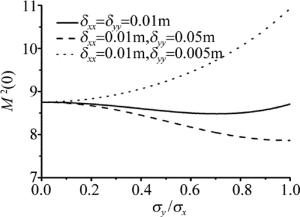
Figure 2. Relationship between M2 factor of an EEMGSM beam and the initial beam-width ratio during anisotropic turbulent propagation
图 3表示在不同初始偏振度值P0的情况下,EEMGSM光束在各向异性湍流中传输时归一化质量因子随距离的变换图像。从图 3可以看出,与光束在自由空间中的传输特性不同,其归一化的质量因子在各向异性湍流中传输时增大,这说明了EEMGSM光束在传输时受到湍流影响导致光束质量下降。在图 3a中,对于Ay>Ax的情况,具有小初始偏振度的EE-MGSM光束的光束质量受各向异性的影响小于具有大初始偏振度的EEMGSM光束或EMGSM光束,这表明与EMGSM光束相比,EEMGSM光束受各向异性湍流的影响较小。从图 3b可知,对于Ay < Ax的情况,随着初始偏振度P0的减小,归一化质量因子的值增加得越快,且标量EMGSM光束受各向异性湍流的影响小于EEMGSM光束。
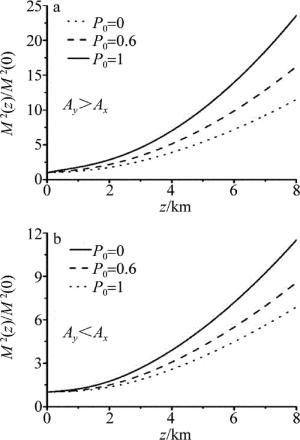
Figure 3. The normalized M2 factor of an EEMGSM beam on propagation in turbulent anisotropy for different values of the initial degree of polarization
图 4a、图 4b分别表示不同初始相干度和不同初始均方根束宽,EEMGSM光束在各向异性湍流中传输的归一化质量因子变化情况。从图 4a中可以看出,随着初始相干度值的减小,归一化质量因子的值在传输时增大得越慢,这意味着具有小初始相干度的EE-MGSM光束受各向异性湍流的影响较小。由图 4a和图 4b可知:EEMGSM光束在具有较大的初始均方根束宽和较小的初始相干度时受各向异性湍流的影响较小。
图 5a反映了EEMGSM光束在各向异性湍流中传输时不同阶数与其归一化质量因子的变化关系,其中σx=σy=0.01m。可知随着阶数的增大,EEMGSM光束的归一化质量因子增大得越慢。从图 5b可以看出, 不同波长EEMGSM光束在各向异性湍流中传输的归一化质量因子变化情况,其中σx=σy=0.02m。另外,湍流参量也影响光束在各向异性湍流中归一化质量因子的演化特性。在图 5c中利用不同的结构常数的值来计算EEMGSM光束在各向异性湍流中传输的归一化质量因子。图 5d是折射率波动谱的幂函数对EEMGSM光束在各向异性湍流中传输时的影响,可以从图中了解到在折射率波动谱的幂函数取值范围内,EEMGSM光束的质量因子先增大后缓慢减小,且阶数越小,质量因子越小。
由图 6可知, 各向异性湍流中传输的EEMGSM光束归一化质量因子与不同湍流内、外尺度变化关系。如图所示,归一化的质量因子随着湍流内尺度减小或湍流外尺度增大而增大得越快。
-
基于拓展的惠更斯-菲涅耳原理和维格纳分布函数的二阶矩理论,推导了EEMGSM光束在各向异性湍流中传输质量因子的解析表达式,并进行相应的数值计算。结果表明:可以利用EEMGSM光束替代EEGSM光束以改善光束的传输特性,减小湍流对光束的影响。当光束横截面上两个方向的初始相干度值相等时,EEMGSM光束要比EMGSM光束具有较小的质量因子,此时EEMGSM光束比EMGSM光束更具有优势。当初始偏振度、初始腰宽、阶数、波长和内尺度增大时,EEMGSM光束的归一化质量因子减小;当初始相干度、结构常数和外尺度减小时,EEMGSM光束的归一化质量因子减小。对比相同条件下的EEMGSM光束与EMGSM光束和EEGSM光束,EEMGSM光束的在缓解湍流影响方面比EEGSM光束和EMGSM光束更具有优势。所得结论对于通信方面的研究可能有一定的参考意义。

 Map
Map


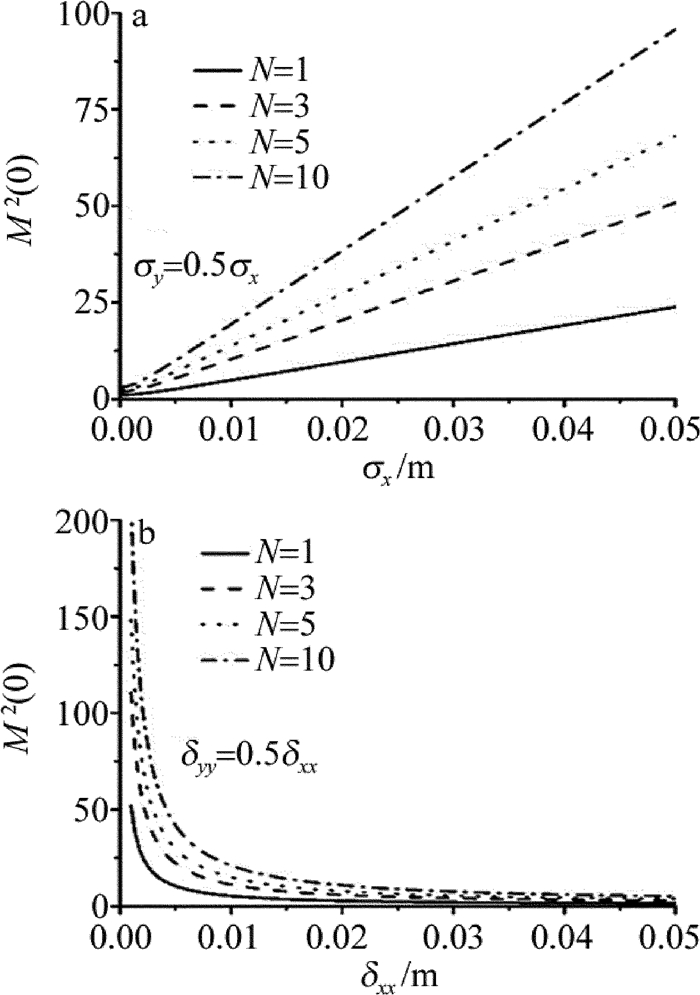

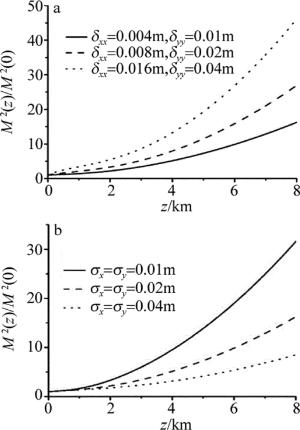

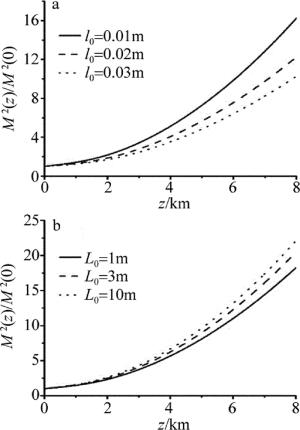
 DownLoad:
DownLoad:
